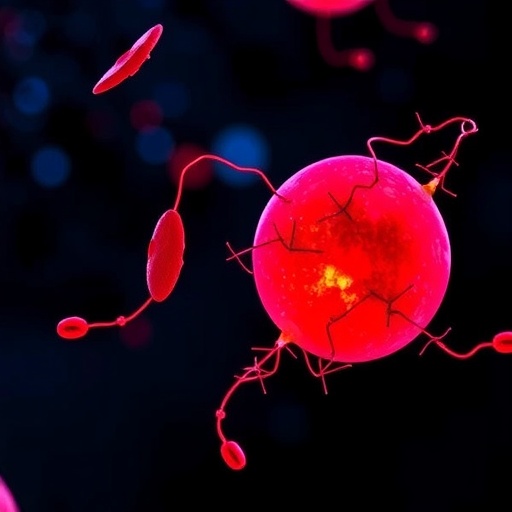Metabolic Adaptations in Erythrocytes: The High-Altitude Hypoxia Revelation
As humanity continues to explore the effects of extreme environments on biological systems, a groundbreaking study has emerged elucidating the metabolic adaptations in erythrocytes—our red blood cells—as a response to chronic hypoxia experienced at high altitudes. Conducted by researchers Yu, Tan, and Zhou, this study dives deep into the physiological changes that occur as the body strives to adapt to limited oxygen availability. The findings are not only significant for understanding human health in extreme conditions but also have implications for improving treatments for various hypoxia-related medical conditions.
High-altitude environments, particularly those exceeding elevations of 2,500 meters, pose a unique physiological challenge due to the reduced atmospheric pressure and subsequent decline in oxygen saturation. As individuals ascend to these altitudes, their bodies initiate complex adaptations to maintain oxygen delivery to tissues. Among these adaptations, the role of erythrocytes becomes crucial. Erythrocytes are responsible for transporting oxygen from the lungs to the rest of the body, and their metabolic efficiencies can significantly influence individual capabilities in high-altitude locations.
The research highlights that chronic exposure to hypoxic conditions triggers significant metabolic alterations within erythrocytes. The study identifies specific enzymatic pathways that become activated or inhibited in response to the low oxygen levels typical of mountainous regions. One of the most striking observations was the enhancement of glycolytic activity, which serves to increase ATP production and optimize energy utilization under oxygen-limited conditions. This metabolic shift suggests that erythrocytes play an active role in responding to high-altitude challenges, rather than functioning solely as passive carriers of oxygen.
Furthermore, the study analyzes the shifts in erythrocyte membrane composition as a consequence of long-term hypoxia. The research indicates an increase in the fluidity of erythrocyte membranes, which may facilitate improved gas exchange and more efficient transport of molecules in low-oxygen environments. This finding underscores the adaptability of red blood cells and highlights the intricate biochemical changes that accompany the body’s acclimatization process at high altitudes.
Another fascinating aspect of the study is the cellular signaling pathways involved in these metabolic changes. The researchers discovered that hypoxia-responsive transcription factors activate the expression of key genes linked to erythrocyte metabolism. This gene expression modulation is a critical aspect of how the body senses and responds to declining oxygen levels, effectively fine-tuning the erythrocyte’s functional capabilities under stress.
The results of this research hold profound implications beyond the context of high-altitude adaptations. Understanding how erythrocytes modify their metabolic profiles could be transformative for developing therapeutic strategies for various conditions associated with inadequate oxygen supply, such as chronic obstructive pulmonary disease (COPD) or ischemic heart disease. Insights gained from these high-altitude studies may lead to innovative treatments aimed at enhancing oxygen delivery mechanisms in afflicted individuals, ultimately improving their quality of life.
Moreover, the study contributes valuable knowledge to the field of genomics. By utilizing cutting-edge sequencing technologies, the researchers were able to delineate the genomic alterations associated with erythrocyte metabolism during hypoxic exposure. This genomic insight assists in further unraveling the complex interactions between genetic predispositions and environmental factors, illuminating pathways that may be harnessed for future research or clinical applications.
In a population renowned for their remarkable adaptations to high altitudes, such as the Sherpas of the Himalayas, this research also opens avenues for exploring genetic variants that may confer advantages in oxygen transport efficiency. By aligning the metabolic findings with genetic markers, future studies can identify individuals who possess inherent advantages for living in hypoxic conditions, fostering innovation in personalized medicine.
As these discoveries continue to unfold, they emphasize the resilience of human physiology and its capacity to endure and thrive in adverse conditions. The resilience exhibited by erythrocytes reveals a sophisticated layer of adaptation that has evolved over generations amid environmental challenges, showcasing the intricate design of biological systems and their unyielding nature.
The study’s implications extend to fields as diverse as sports science and evolutionary biology. Understanding how metabolic alterations influence athletic performance in high-altitude settings can inform training regimens for athletes seeking to optimize their endurance and efficiency. Meanwhile, insights into the evolutionary mechanisms behind endurance adaptations at high altitudes can shed light on how human populations have developed unique traits to survive in some of the planet’s most inhospitable environments.
In summary, the research conducted by Yu, Tan, and Zhou provides a comprehensive view of the metabolic alterations in erythrocytes as a response to long-term hypoxia at high altitudes. From enzymatic adjustments to membrane fluidity and genetic adaptations, the findings reveal a remarkable narrative of resilience and adaptation inherent in human physiology. As we look to the future, this research not only expands our understanding of how humans cope with extreme environments, but it also paves the way for therapeutic advancements that can enhance health and performance in the face of oxygen deprivation.
By uncovering the molecular intricacies and adaptations of erythrocytes more than ever before, we are invited to appreciate the complexities of life itself, and the incredible lengths our bodies go to ensure survival and thrive in a world filled with challenges.
Subject of Research: Metabolic alterations in erythrocytes associated with long-term hypoxia at high altitude.
Article Title: Metabolic alterations in erythrocytes associated with long-term hypoxia at high altitude.
Article References:
Yu, T., Tan, C., zhou, C. et al. Metabolic alterations in erythrocytes associated with long-term hypoxia at high altitude.
BMC Genomics 26, 940 (2025). https://doi.org/10.1186/s12864-025-12107-6
Image Credits: AI Generated
DOI: 10.1186/s12864-025-12107-6
Keywords: high altitude, hypoxia, erythrocytes, metabolism, adaptation, genomics, physiological changes, oxygen transport, endurance, human physiology, evolutionary biology.




